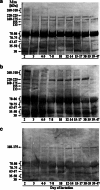Lectin-based analysis of fucosylated glycoproteins of human skim milk during 47 days of lactation
- PMID: 26318738
- PMCID: PMC4651984
- DOI: 10.1007/s10719-015-9615-5
Lectin-based analysis of fucosylated glycoproteins of human skim milk during 47 days of lactation
Abstract
Glycoproteins of human milk are multifunctional molecules, and their fucosylated variants are potentially active molecules in immunological events ensuring breastfed infants optimal development and protection against infection diseases. The expression of fucosylated glycotopes may correspond to milk maturation stages. The relative amounts of fucosylated glycotopes of human skim milk glycoproteins over the course of lactation from the 2(nd) day to the 47(th) day were analyzed in colostrums, transitional and mature milk samples of 43 healthy mothers by lectin-blotting using α1-2-, α1-6-, and α1-3-fucose specific biotinylated Ulex europaeus (UEA), Lens culinaris (LCA), and Lotus tetragonolobus (LTA) lectins, respectively. The reactivities of UEA and LCA with the milk glycoproteins showed the highest expression of α1-2- and α1-6-fucosylated glycotopes on colostrum glycoproteins. The level of UEA-reactive glycoproteins from the beginning of lactation to the 14(th) day was high and relatively stable in contrast to LCA-reactive glycoproteins, the level of which significantly decreased from 2-3 to 7-8 days then remained almost unchanged until the 12(th)-14(th) days. Next, during the progression of lactation the reactivities with both lectins declined significantly. Eighty percent of α1-2- and/or α1-6-fucosylated glycoproteins showed a high negative correlation with milk maturation. In contrast, most of the analyzed milk glycoproteins were not recognized or weakly recognized by LTA and remained at a low unchanged level over lactation. Only a 30-kDa milk glycoprotein was evidently LTA-reactive, showing a negative correlation with milk maturation. The gradual decline of high expression of α1-2- and α1-6-, but not α1-3-, fucoses on human milk glycoproteins of healthy mothers over lactation was associated with milk maturation.
Keywords: Fucose; Fucosylated glycotopes; Human milk glycoproteins; Lactation; Lectins.
Figures



Similar articles
-
The Impact of Dietary Fucosylated Oligosaccharides and Glycoproteins of Human Milk on Infant Well-Being.Nutrients. 2020 Apr 16;12(4):1105. doi: 10.3390/nu12041105. Nutrients. 2020. PMID: 32316160 Free PMC article. Review.
-
Lactation stage-related expression of sialylated and fucosylated glycotopes of human milk α-1-acid glycoprotein.Breastfeed Med. 2014 Jul-Aug;9(6):313-9. doi: 10.1089/bfm.2014.0011. Epub 2014 Jun 3. Breastfeed Med. 2014. PMID: 24892765 Free PMC article.
-
Terminal glycotope expression on milk fibronectin differs from plasma fibronectin and changes over lactation.Clin Biochem. 2015 Feb;48(3):167-73. doi: 10.1016/j.clinbiochem.2014.11.011. Epub 2014 Nov 20. Clin Biochem. 2015. PMID: 25464017
-
O-glycosylation of α-1-acid glycoprotein of human milk is lactation stage related.Breastfeed Med. 2015 Jun;10(5):270-6. doi: 10.1089/bfm.2015.0049. Breastfeed Med. 2015. PMID: 26057552 Free PMC article.
-
[The significance of fucosylated glycoconjugates of human milk in nutrition of newborns and infants].Postepy Hig Med Dosw (Online). 2015 Jul 22;69:811-29. doi: 10.5604/17322693.1162561. Postepy Hig Med Dosw (Online). 2015. PMID: 26206995 Review. Polish.
Cited by
-
Core Fucosylation of Maternal Milk N-Glycan Evokes B Cell Activation by Selectively Promoting the l-Fucose Metabolism of Gut Bifidobacterium spp. and Lactobacillus spp.mBio. 2019 Apr 2;10(2):e00128-19. doi: 10.1128/mBio.00128-19. mBio. 2019. PMID: 30940702 Free PMC article.
-
Changes in Human Milk Immunoglobulin Profile During Prolonged Lactation.Front Pediatr. 2020 Aug 7;8:428. doi: 10.3389/fped.2020.00428. eCollection 2020. Front Pediatr. 2020. PMID: 32850542 Free PMC article.
-
The Impact of Dietary Fucosylated Oligosaccharides and Glycoproteins of Human Milk on Infant Well-Being.Nutrients. 2020 Apr 16;12(4):1105. doi: 10.3390/nu12041105. Nutrients. 2020. PMID: 32316160 Free PMC article. Review.
-
Lectin-Based Method for Deciphering Human Milk IgG Sialylation.Molecules. 2019 Oct 22;24(20):3797. doi: 10.3390/molecules24203797. Molecules. 2019. PMID: 31652515 Free PMC article.
-
Fucosylated Human Milk Oligosaccharides and N-Glycans in the Milk of Chinese Mothers Regulate the Gut Microbiome of Their Breast-Fed Infants during Different Lactation Stages.mSystems. 2018 Dec 26;3(6):e00206-18. doi: 10.1128/mSystems.00206-18. eCollection 2018 Nov-Dec. mSystems. 2018. PMID: 30637338 Free PMC article.
References
-
- ESPGHAN Committee on Nutrition. Agostoni C, Braegger C, Decsi T, Kolacek S, Koletzko B, Michaelsen KF, Mihatsch W, Moreno LA, Puntis J, Shamir R, Szajewska H, Turck D, van Goudoever J. Breast-feeding: a commentary by the ESPGHAN committee on nutrition. J. Pediatr. Gastroenterol. Nutr. 2009;49:112–125. doi: 10.1097/MPG.0b013e31819f1e05. - DOI - PubMed
-
- Ruiz-Palacios GM, Cervantes LE, Ramos P, Chavez-Munguia B, Newburg DS. Campylobacter jejuni binds intestinal H(O) antigen (Fuc alpha 1, 2Gal beta 1, 4GlcNAc), and fucosyloligosaccharides of human milk inhibit its binding and infection. J. Biol. Chem. 2003;278:14112–14120. doi: 10.1074/jbc.M207744200. - DOI - PubMed
Publication types
MeSH terms
Substances
LinkOut - more resources
Full Text Sources
Other Literature Sources
Research Materials

